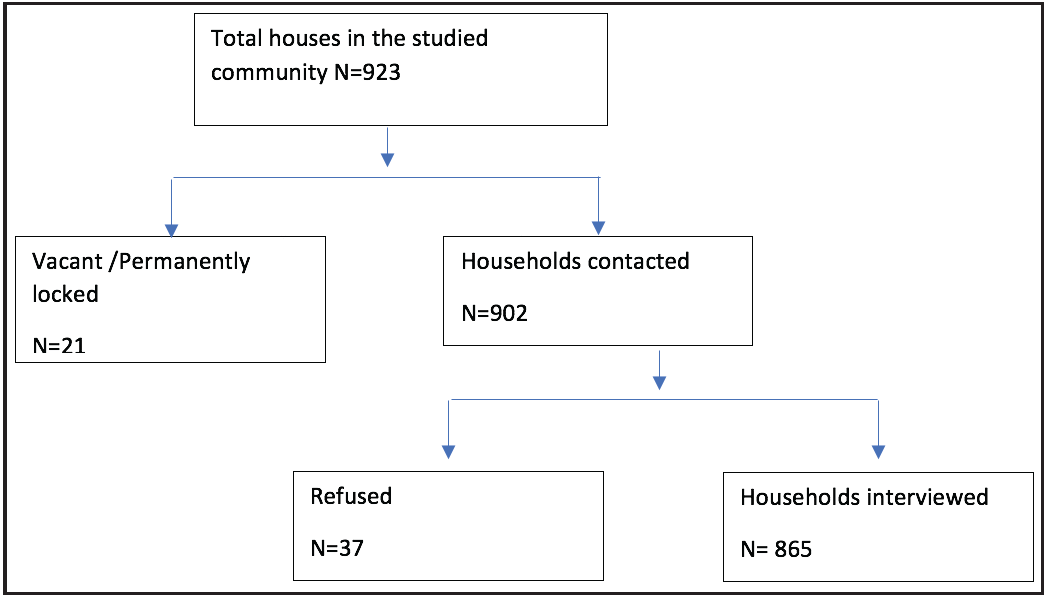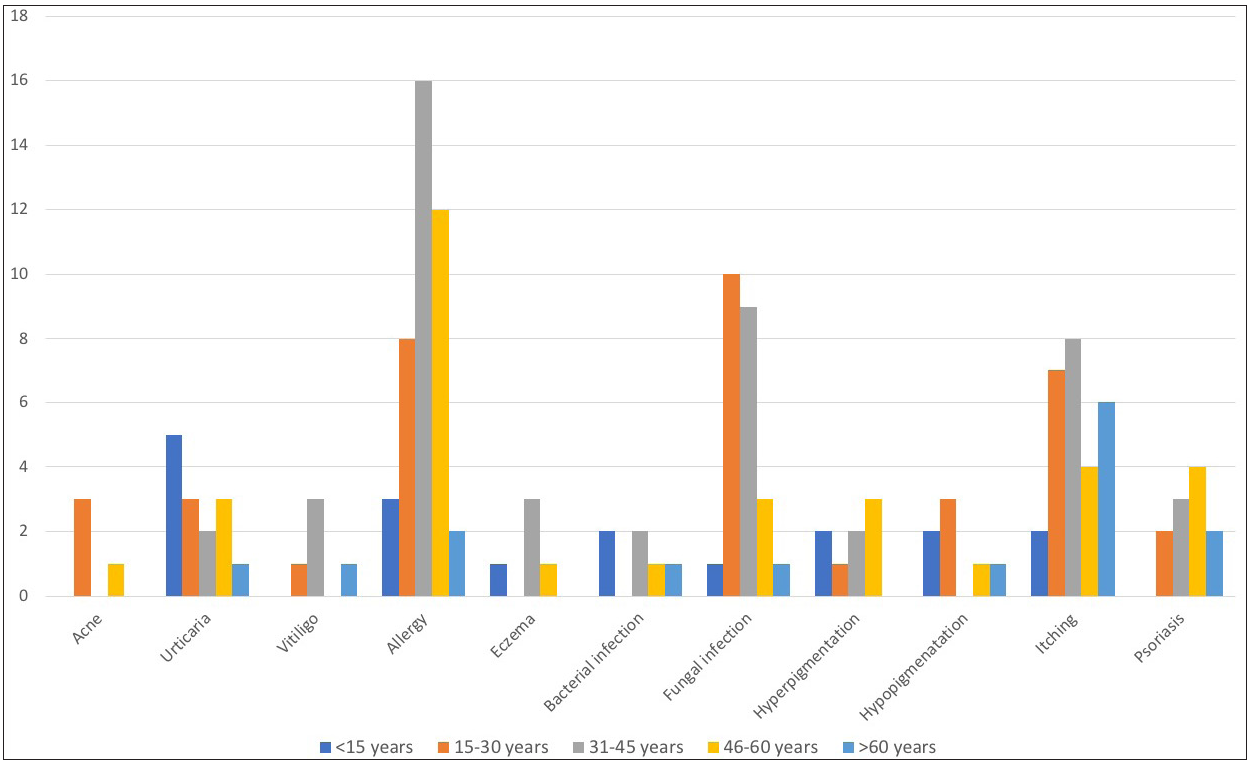Translate this page into:
Self-reported prevalence of skin problems among residents of a peri-urban community of Chandigarh
Corresponding author: Dr. Tarun Narang, Department of Dermatology, Venereology and Leprology, Postgraduate Institute of Medical Education and Research, Chandigarh, India. narangtarun@yahoo.co.in
-
Received: ,
Accepted: ,
How to cite this article: Kavita K, Mehta H, Ghai S, Saini SK, Narang T. Self-reported prevalence of skin problems among residents of a peri-urban community of Chandigarh. Indian J Dermatol Venereol Leprol. 2024;90:565. doi: 10.25259/IJDVL_982_2022
Dear Editor,
In India, like several other countries, dermatologists are few and concentrated in urban areas, limiting access to skin care in rural and peri urban locations. Focussing on a few commonly occurring skin conditions might go a long way in reducing overall burden of skin diseases in the community. However, the scarcity of data on population-based prevalence of skin disorders makes this difficult. We conducted this survey to assess prevalence of skin disorders in a peri-urban community near Chandigarh.
This population based cross-sectional study was carried out to assess prevalence of skin diseases/problems among the residents of selected peri-urban community of Chandigarh. All residents of the selected area, irrespective of age or gender, were interviewed by health care workers (nursing students with training in common dermatoses) to assess the prevalence of skin diseases (as perceived by the patient) after a written informed consent [Figure 1].

- Response rates of households in study population
Data were collected with the help of an interview schedule that included socio-demographic profile of subjects, questions related to the presence of skin disorders and hygienic practices of subjects. During the interview, subjects were asked about the presence of any skin complaints at the time of data collection or within the past 1 year. Patients responding affirmatively to this question were further inquired whether they had sought medical care for their symptoms. Medical records were reviewed wherever available. Responders with a diagnosed cutaneous condition were recorded as having a “skin disease” Additional questions about type of treatment and facility from where the treatment was taken were asked from the subjects with “skin diseases”. Responders who had not sought health care services were recorded as having a “skin problem” and their symptoms, for example, itching, hair fall etc., were recorded verbatim. Questions regarding frequency of bathing, changing clothes and changing undergarments were also asked to assess hygiene practices. Socioeconomic classification of study participants was performed as per the BG Parsad scale1.
A total of 3807 participants were enrolled from 865 households, 1990 (52.3%) of whom were males, with a mean age of 33.5 years. Socio-demographic profile of study population is summarised in Table 1.
| S. No. | Variable | No. of patients (%) |
|---|---|---|
| 1 | Age (in Years) | — |
| <15 | 749 (19.7) | |
| 16–30 | 1050 (27.6) | |
| 31–45 | 1039 (27.3) | |
| 46–60 | 626 (16.4) | |
| >60 | 343 (9.0) | |
| 2 | Sex | |
| Male | 1990 (52.3) | |
| Female | 1817 (47.7) | |
| 3 | Family size | |
| 2 | 81 (9.4) | |
| 5 | 627 (72.6) | |
| 8 | 136 (15.7) | |
| >9 | 20 (2.3) | |
| 4 | Monthly per capita income (n = 864) | |
| 7008 and above (Upper high) | 236 (27.3) | |
| 3504–7007 (Upper middle class) | 395 (45.7) | |
| 2102–3503 (Middle class) | 158 (18.3) | |
| 1051–2101 (Lower middle class) | 66 (7.6) | |
| Below 1050 (Lower) | 9 (1) | |
| 5 | Frequency of bathing (n = 3807) | |
| Once a day | 3685 (96.7) | |
| Twice a day | 103 (2.4%) | |
| Thrice a day | 11 (0.2%) | |
| Alternate days | 8 (0.02%) | |
| 6 | Frequency of changing undergarments | |
| Every day | 3737 (98.2%) | |
| Twice a day | 53 (1.4%) | |
| Alternate days | 17 (0.4%) | |
| 7 | Frequency of changing clothes | |
| Every day | 3726 (97.8%) | |
| Twice a day | 59 (1.5%) | |
| Alternate days | 22 (0.5%) |
Majority of the patients were in the age group of 16–30 years (1050, 27.6%) and 31–45 years (1039, 27.3%). A total of 159 participants reported having a dermatological complaint. Table 2 presents the prevalence and gender distribution of skin complaints among the studied population. Overall prevalence of self-reported skin complaints in the present study was 41.7 per 1000 population. Among “skin problems,” allergy was the most common self-reported skin complaint (with the prevalence rate of 10.8 per 1000 population) followed by itching (7.1 per 1000 population). Among patients with a diagnosed “skin disease,” fungal infection (6.3 per 1000 population) was the most common diagnosis, followed by psoriasis, urticaria, atopic dermatitis and vitiligo (2.9, 3.7, 1.3, and 1.3 per 1000 population, respectively).
| Self- reported skin problems | Prevalence per 1000 (95% CI) | Sex wise prevalence per 1000 | |
|---|---|---|---|
| N = 3807 | Female (n = 1817) | Male (n = 1990) | |
| Acne | 1.1 (0–3) | 1.7 | 0.5 |
| Allergy | 10.8 (8–15.1) | 11 | 10.6 |
| Eczema | 1.3 (0–3) | 1.1 | 1.5 |
| Bacterial infection | 1.6 (1.1–3) | 1.7 | 1.5 |
| Fungal infection | 6.3 (4–9.1) | 5 | 7.5 |
| Hyperpigmentation | 2.1 (1–4.2) | 2.8 | 1.5 |
| Hypopigmentation | 1.8 (1–4) | 1.7 | 2 |
| Itching | 7.1 (5–10) | 8.8 | 5.5 |
| Psoriasis | 2.9 (1–5) | 3.3 | 2.5 |
| Sunburn | 0.5 (0–2) | 1.1 | 0 |
| Urticaria | 3.7 (2–6) | 4.4 | 3 |
| Vitiligo | 1.3 (0–3) | 1.7 | 1 |
| Warts | 0.5 (0–2.1) | 0.6 | 0.5 |
| Hair fall | 0.3 (0–1) | 0.6 | 0 |
| Chickenpox | 0.3 (0–1) | 0 | 0.5 |
| NONE | 958.2 (951.1–964.2) | 954.3 | 961.8 |
Age distribution of prevalent skin diseases and problems is presented in Figure 2. Fungal infection (n = 24) was observed to be more common in 15–30 years (n = 10) and 31–45 years (n = 9) age groups. Skin problems due to an allergy (n = 41) and diagnosed eczema (n = 5) were most common among participants aged 31–45 years (n = 16 and 3, respectively). Acne (n = 4) was more prevalent among individuals aged 15–30 years (n = 3). No significant difference was observed in prevalence of skin disorders among the two genders.

- Age distribution of participants with skin diseases or problems (n = 159)
Nearly one-fourth (23.9%) of the subjects were not taking any form of treatment. Among 121 participants (67.1%) who had sought treatment, 106 (87.6%) were taking medications prescribed by a dermatologist or a general practitioner. In addition, 4 (3.3%) and 3 (2.5%) participants had opted for ayurvedic and homeopathic treatments, respectively while 3 (2.5%) other participants were visiting quacks and 5 (4.1%) were self-medicating.
Fungal infections were the leading infectious etiology in the present study. We observed allergies and itching to be the leading skin problems, however, as these were reported by the patients, the exact etiology cannot be ascertained. High prevalence of allergy and itching can also be attributed to the fact that these problems were self-reported and are a common manifestations of several dermatoses.
The strength of our study includes a population-based design, free from referral bias. This is the first population-based study on self-reported prevalence of skin conditions in Indian population. Limitations include recall bias, as the morbidities were self-reported and some dermatoses may have been missed as dermatological examination was not performed.
Present study as well as majority of previous studies have reported fungal infections and dermatitis as the most common etiology [Table 3].2–6 Training of primary health care staff in prevention and management of these two conditions will aid in reducing burden of skin diseases.
| Source | Setting | Location | Mode of detection of skin diseases | Prevalence of skin disorders | Most common skin disorder | Most common age group affected |
|---|---|---|---|---|---|---|
| Dogra et al. 20031 | School children | Suburban areas around Chandigarh | Physical examination based | 38.8% | Infections: pyoderma, non-infectious: eczemas | Only patients aged 6–14 years included |
| Singhal et al. 20202 | Population based, store & foreword teledermatology | Dahod, Gujarat | Clinical photograph based | 20% | Infections: Fungal diseases, non-infectious: eczemas | >60 years |
| Grover et al. 20083 | Medical health camp | Kaushambi, Allahabad, Uttar Pradesh | Physical examination based | 7.86% | Infections: Fungal diseases, non-infectious: eczemas | 11–20 years |
| Rao et al. 20034 | Medical health camp | Kumble, Kerela | Physical examination based | 11.6% | Infections: Fungal diseases, non-infectious: eczemas | NR |
| Jain et al. 20165 | Medical health camps | In and around Wardha, Maharashtra | Physical examination based | NR | Infections: Fungal diseases, non-infectious: eczemas | 21–30 years |
| Present study | Population based | Peri urban community near Chandigarh | Interview-based | 4.17% | Fungal infections | 15–30 years |
NR: not reported
Declaration of patient consent
Patient’s consent not required as patients identity is not disclosed or compromised.
Financial support and sponsorship
Nil.
Conflict of interest
There are no conflicts of interest.
References
- Prasad’s Socioeconomic Scale Updated For 2019. National Journal of Community Medicine.. 2019;10:388.
- [Google Scholar]
- Epidemiology of skin diseases in school children: a study from northern India. Pediatr Dermatol. 2003;20:470-3.
- [CrossRef] [PubMed] [Google Scholar]
- Prevalence and pattern of skin diseases in tribal villages of Gujarat: A teledermatology approach. Indian Journal of Community Medicine. 2020;45:199-203.
- [CrossRef] [PubMed] [PubMed Central] [Google Scholar]
- A cross section of skin diseases in rural Allahabad. Indian J Dermatol.. 2008;53:179-81.
- [CrossRef] [PubMed] [Google Scholar]
- Pattern of skin diseases in an Indian village. Indian J Med Sci. 2003;57:108-10.
- [PubMed] [Google Scholar]
- Prevalence of skin diseases in rural Central India: A community-based, cross-sectional, observational study. Journal of Mahatma Gandhi Institute of Medical Sciences. 2016;21:111.
- [Google Scholar]






